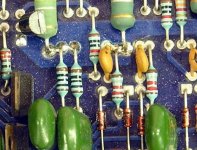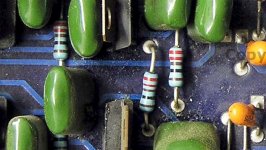I have a orion 2250sx amp it fried a resistor on the output side, it fried it pretty bad, i believe its a 22 ohm resistor but cant tell, if anybody has a copy of the schematics or is willing to open up there amp and take some pics it would be greatly appreciated. also if someone could let me know where to find mil spec resistors that would be helpful too. i can post pictures later if need be.
Try this link to AMP-Guts, they show SX2250:
http://ampguts.realmofexcursion.com/Orion_SX2250/
Good luck
http://ampguts.realmofexcursion.com/Orion_SX2250/
Good luck
here is a pic of the board.
An externally hosted image should be here but it was not working when we last tested it.
another thing can you tell me what ohm the resistor to the left of that one is, the brown 22 ohm one on my amp it just doesnt look right, i want to make sure it is correct. but thanks for the help on the 100 ohm resistor i will pick one up tomorrow and try it out hope it fixes it. thanks again for your help!
The resistor in your board appears to be a 220 ohm 5% (red red, brown gold). The one in the attached photo appears to be a 221 ohm 1% (red, red, brown, black brown). If that's the case, it probably doesn't need to be changed.
I'd expect to see at least one shorted driver transistor (MPSU07/MPSU57). Have you checked the output transistors to see if any are shorted?
I'd expect to see at least one shorted driver transistor (MPSU07/MPSU57). Have you checked the output transistors to see if any are shorted?
Attachments
so i replaced the resistor and checked the transistors, they all checked out good, i then hook up a 10 amp battery charger, at first the power light came on for about 2 seconds, then the coils started to hum and then the light went out, now whenever i hook up the charger no lights come on and the charger cuts out from overload in a couple of seconds, something is shorted out any ideas? i only checked the transistors on the side closest to the resistor that was burnt should i check both sides? let me know what you think.
In general, battery chargers are not a good 12 volt power source. If used with a battery, they are typically safe but without a battery connected, the output can be much more than 12 volts. If they have a boost capability, the output current could be much higher than the rated current.
It's possible that a component (driver, output transistor...) was injured and now has shorted, causing the new symptoms.
Check all of the output transistors (the ones with the third leg connected to the large emitter resistors). Since it will only take a couple of seconds, you may as well check them in both channels.
If you can't find any defective output transistors, a driver is likely the culprit.
If the amp was clamped in the sink, the power supply transistors should have survived but you should give them a quick check also. Check these from the center leg to both outer legs. Neither should show a short (0 ohms). The power supply transistors are the ones near the transformers. The first leg will be connected to a low value resistor (~10 ohms).
It's possible that a component (driver, output transistor...) was injured and now has shorted, causing the new symptoms.
Check all of the output transistors (the ones with the third leg connected to the large emitter resistors). Since it will only take a couple of seconds, you may as well check them in both channels.
If you can't find any defective output transistors, a driver is likely the culprit.
If the amp was clamped in the sink, the power supply transistors should have survived but you should give them a quick check also. Check these from the center leg to both outer legs. Neither should show a short (0 ohms). The power supply transistors are the ones near the transformers. The first leg will be connected to a low value resistor (~10 ohms).
Check the rest of them as suggested above.
You can continue testing if only one was blown but it's VERY rare to have only one blown power supply FET when one is blown in a way that the damage is visible. To properly repair the amp, you'll need to replace ALL of the FETs on that half of the power supply. On the old amps, there were 14 total per supply. I'm not sure what you have on the newer version.
The smp60n06 is discontinued. There are many replacements available. I'd use an IRF3205PBF. An huf75339p3 is also a good replacement.
If/when you replace the power supply FETs, you need to replace the drivers also. They are MPSA06/MPSA56. If you use the IRF3205s, I'd suggest using the MPSW06 and MPSW56 as replacement drivers.
You can continue testing if only one was blown but it's VERY rare to have only one blown power supply FET when one is blown in a way that the damage is visible. To properly repair the amp, you'll need to replace ALL of the FETs on that half of the power supply. On the old amps, there were 14 total per supply. I'm not sure what you have on the newer version.
The smp60n06 is discontinued. There are many replacements available. I'd use an IRF3205PBF. An huf75339p3 is also a good replacement.
If/when you replace the power supply FETs, you need to replace the drivers also. They are MPSA06/MPSA56. If you use the IRF3205s, I'd suggest using the MPSW06 and MPSW56 as replacement drivers.
You only need 2 of each of the drivers for the power supply but they're cheap so get a few extras of each. Any time you order parts, you should order more than you need.
Before you can order parts, you need to find as many defects as possible.
How many of the other FETs were damaged?
Did you check the MPSU07/MPSU57 drivers in the audio section to see if any were shorted?
When you power this amp up, you will need a better power supply and a 10 amp fuse for the B+ line.
If there are more problems in the audio section that are causing the amp to draw excessive current (blowing the 10 amp fuse), you may need to use a current limiter to allow the amp to power up (or attempt to power up) to allow further troubleshooting. The easiest to get is an automotive headlamp. An H6054 is a good choice. If you plan on doing this type of work often, you may want to order a 50 or 100 watt tubular ceramic resistor (1.5-2 ohms) for a current limiter. The 2 ohm resistors can double as a dummy load when the amp is ready for testing.
There are no real improvements that can be made to the amp. Unless the caps are swollen or show signs of overheating, they should be left as is.
Before you can order parts, you need to find as many defects as possible.
How many of the other FETs were damaged?
Did you check the MPSU07/MPSU57 drivers in the audio section to see if any were shorted?
When you power this amp up, you will need a better power supply and a 10 amp fuse for the B+ line.
If there are more problems in the audio section that are causing the amp to draw excessive current (blowing the 10 amp fuse), you may need to use a current limiter to allow the amp to power up (or attempt to power up) to allow further troubleshooting. The easiest to get is an automotive headlamp. An H6054 is a good choice. If you plan on doing this type of work often, you may want to order a 50 or 100 watt tubular ceramic resistor (1.5-2 ohms) for a current limiter. The 2 ohm resistors can double as a dummy load when the amp is ready for testing.
There are no real improvements that can be made to the amp. Unless the caps are swollen or show signs of overheating, they should be left as is.
- Status
- This old topic is closed. If you want to reopen this topic, contact a moderator using the "Report Post" button.
- Home
- General Interest
- Car Audio
- need help with 250sx

